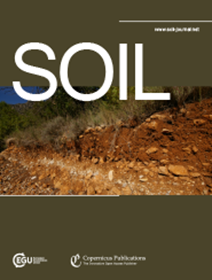在整个有机农场中,土壤健康管理驱动土壤有机质比土壤特性更重要
IF 4.3
2区 农林科学
Q1 SOIL SCIENCE
引用次数: 0
摘要
摘要。耕地土壤有机碳(SOC)重建对减缓气候变化和改善土壤功能具有关键作用,但其积累受到管理决策和土壤固有性质的制约。科学家和农场顾问建议农民种植覆盖作物,减少耕作,并添加有机改良剂来增加有机碳,然而,旨在改善土壤健康的做法的有效性可能受到潜在的土壤控制因素的限制,如矿物学,质地和ph。鉴于有机碳由两个不同的部分组成-颗粒有机质(POM)和矿物相关有机质(MAOM) -它们的稳定性和对管理的反应不同,一个关键问题出现了:固有的土壤特性在多大程度上限制了推荐的土壤健康实践在增加有机碳方面的有效性?尽管在受控的田间环境中进行了广泛的研究,但对现实农业环境的了解仍然很少,这限制了我们预测不同土壤条件下有机碳收益的能力。在这里,我们评估了当季和最近(<;5年)在工作农场实施的土壤健康管理系统如何影响加州中部海岸28个种植绿叶蔬菜的有机田的有机碳含量和储量。我们发现,持续的生物覆盖(例如,通过覆盖种植)增加了我们测量的三个碳库——无POM、MAOM和表层土壤总碳储量——而减少干扰(即减少耕作)增加了两个无POM和MAOM。作物多样性增加了游离和封闭的POM组分。令人惊讶的是,有机物质的修正并没有显示出与任何测量的碳库的任何关系。平均而言,管理变量解释的差异是土壤变量的3.7倍,而对于碳储量,情况正好相反:土壤变量解释的差异是管理变量的2.1倍。我们的研究结果强调,在不同的土壤条件下,土壤健康实践,特别是连续覆盖,可以显著增加土壤碳水平,包括颗粒和矿物相关的有机质组分。本文章由计算机程序翻译,如有差异,请以英文原文为准。
Soil Health Management Drives Soil Organic Matter More Than Edaphic Properties Across Working Organic Farms
Abstract. Rebuilding soil organic carbon (SOC) on working lands plays a pivotal role in mitigating climate change and improving soil function, yet its accumulation is constrained by both management decisions and inherent soil properties. Scientists and farm advisors recommend that farmers plant cover crops, reduce tillage, and add organic amendments to increase SOC, yet the effectiveness of practices intended to improve soil health may be limited by underlying edaphic controls such as mineralogy, texture, and pH. Given that SOC consists of two distinct fractions—particulate organic matter (POM) and mineral-associated organic matter (MAOM)—which differ in their stability and response to management, a critical question emerges: How much do inherent soil properties limit the effectiveness of recommended soil health practices in increasing SOC? Despite extensive research in controlled field settings, real-world farming contexts remain less understood, limiting our ability to predict SOC gains across diverse soil conditions. Here, we evaluate how in-season and recent (<5 yr) implementation of soil health management systems on working farms affects SOC fractions and stocks across 28 organic fields growing leafy greens in the Central Coast of California. We find that continuous living cover (e.g., through cover cropping) increases three of our measured carbon pools – free POM, MAOM, and surface soil total carbon stocks – while reduced disturbance (i.e., less tillage) increases two – free POM and MAOM. Crop diversity enhances both free and occluded POM fractions. Surprisingly, organic matter amendments do not show any relationship with any of the measured carbon pools. On average, management variables explain 3.7 times more variance than edaphic variables across carbon fractions, whereas, for carbon stocks, the opposite is true: edaphic variables explain ~2.1 times the variance compared to management. Our findings highlight that soil health practices, and in particular continuous cover, can significantly increase soil carbon levels, including both particulate and mineral-associated organic matter fractions, across diverse soil conditions.
求助全文
通过发布文献求助,成功后即可免费获取论文全文。
去求助
来源期刊

Soil
Agricultural and Biological Sciences-Soil Science
CiteScore
10.80
自引率
2.90%
发文量
44
审稿时长
30 weeks
期刊介绍:
SOIL is an international scientific journal dedicated to the publication and discussion of high-quality research in the field of soil system sciences.
SOIL is at the interface between the atmosphere, lithosphere, hydrosphere, and biosphere. SOIL publishes scientific research that contributes to understanding the soil system and its interaction with humans and the entire Earth system. The scope of the journal includes all topics that fall within the study of soil science as a discipline, with an emphasis on studies that integrate soil science with other sciences (hydrology, agronomy, socio-economics, health sciences, atmospheric sciences, etc.).
 求助内容:
求助内容: 应助结果提醒方式:
应助结果提醒方式:


